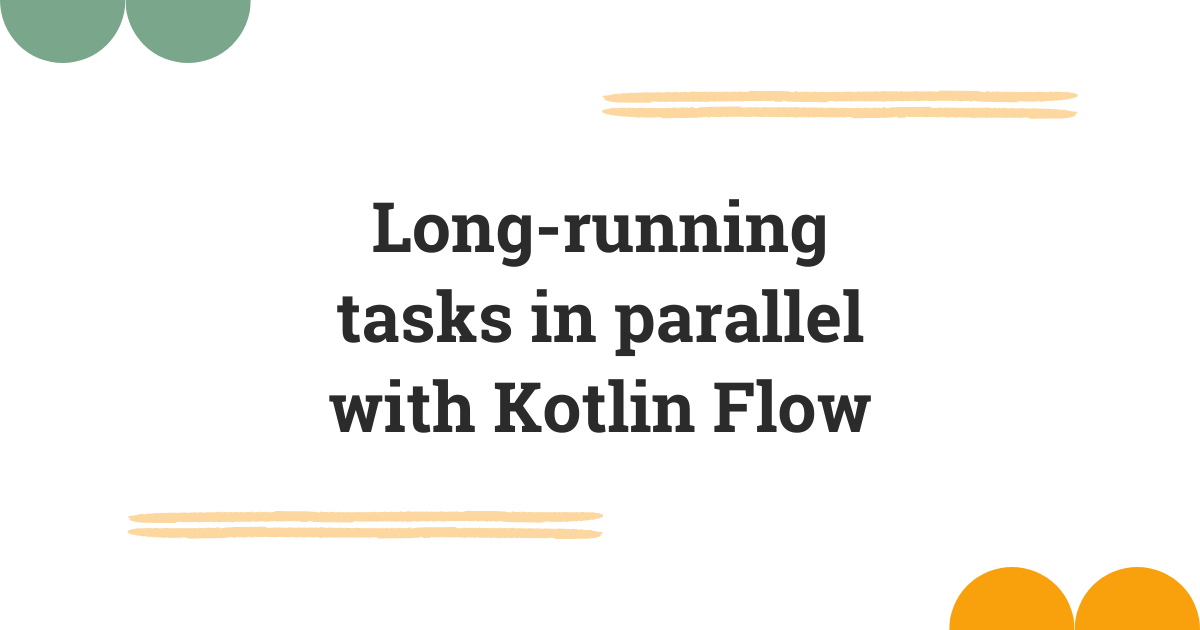Long-running tasks in parallel with Kotlin Flow
- Authors
- Name
- Amit Shekhar
- Published on
I am Amit Shekhar, Co-Founder @ Outcome School, I have taught and mentored many developers, and their efforts landed them high-paying tech jobs, helped many tech companies in solving their unique problems, and created many open-source libraries being used by top companies. I am passionate about sharing knowledge through open-source, blogs, and videos.
Join Outcome School and get high paying tech job: Outcome School
Before we start, I would like to mention that, I have released a video playlist to help you crack the Android Interview: Check out Android Interview Questions and Answers.
In this blog, we will learn about how to run long tasks in parallel with Kotlin Flow in Android.
This blog is a part of the series I have written on Flow API in Kotlin:
- Mastering Flow API in Kotlin
- Creating Flow Using Flow Builder in Kotlin
- Terminal Operators in Kotlin Flow
- Cold Flow vs Hot Flow
- StateFlow and SharedFlow
- Long-running tasks in parallel with Kotlin Flow - YOU ARE HERE
- Retry Operator in Kotlin Flow
- Retrofit with Kotlin Flow
- Room Database with Kotlin Flow
- Kotlin Flow Zip Operator for Parallel Multiple Network Calls
- Instant Search Using Kotlin Flow Operators
- Exception Handling in Kotlin Flow
- callbackFlow - Callback to Flow API in Kotlin
- Unit Testing ViewModel with Kotlin Flow and StateFlow
I will be using the following project for the implementation part. The project follows a basic MVVM Architecture for simplicity. You can find the complete code for the implementation mentioned in this blog in the project itself.
GitHub Project: Learn Kotlin Flow
For running the long tasks in parallel, we will be needing the zip operator of Kotlin Flow. So, we need to understand what is a zip operator of Kotlin Flow.
What is a zip operator of Kotlin Flow?
Zip Operator is an operator that combines the emissions of two flow collections together via a specified function and emits single items for each combination based on the results of this function.
Let's understand the marble diagram with the example code:
val flowOne = flowOf(1, 2, 3)
val flowTwo = flowOf("A", "B", "C")
flowOne.zip(flowTwo) { intValue, stringValue ->
"$intValue$stringValue"
}.collect {
println(it)
}
The output will be the following:
1A
2B
3C
Long-running tasks in parallel
A real use case in Android: When we want to run two tasks in parallel and want the results of both tasks in a single callback when both tasks are completed.
Let's see the code implementation.
Suppose we have two long-running tasks.
Long Running Task One:
private fun doLongRunningTaskOne(): Flow<String> {
return flow {
// your code for doing a long running task
// Added delay to simulate
delay(5000)
emit("One")
}
}
Long Running Task Two:
private fun doLongRunningTaskTwo(): Flow<String> {
return flow {
// your code for doing a long running task
// Added delay to simulate
delay(5000)
emit("Two")
}
}
Now, using the zip operator:
fun startLongRunningTask() {
viewModelScope.launch {
doLongRunningTaskOne()
.zip(doLongRunningTaskTwo()) { resultOne, resultTwo ->
return@zip resultOne + resultTwo
}
.flowOn(Dispatchers.Default)
.catch { e ->
// handle exception
}
.collect {
// result
}
}
}
The output will be the following:
OneTwo
Here, as we have used a zip operator, it runs both tasks in parallel and gives the results of both tasks in a single callback when both tasks are completed.
By zipping two flow collections using the Zip operator, both tasks run in parallel. And we get the result when both get completed. In this way, we get the results of both the flow collections at a time.
Advantages of Zip Operator of Kotlin Flow:
- Run tasks in parallel.
- Return the results of tasks in a single callback when all the tasks are completed.
This way we can use the Zip Operator of Flow in Kotlin for running the tasks in parallel.
Prepare yourself for Android Interview: Android Interview Questions
That's it for now.
Thanks
Amit Shekhar
Co-Founder @ Outcome School
You can connect with me on:
Follow Outcome School on:
